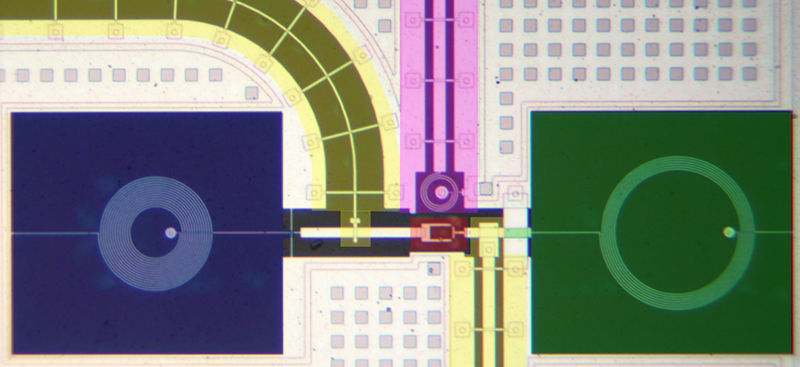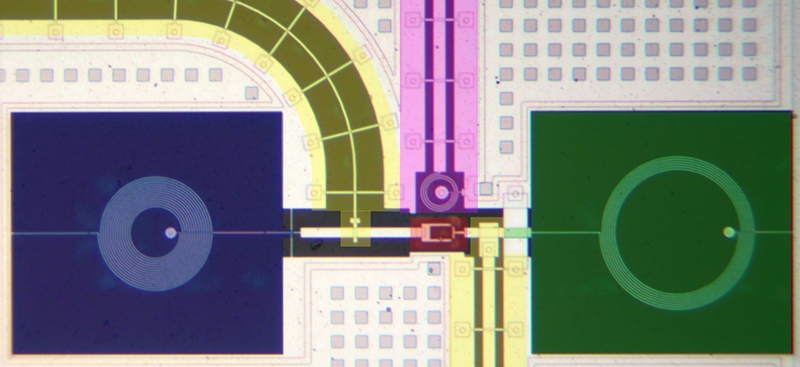One In, Three Out for Microwave Photons
The ability to detect a single microwave photon’s worth of energy remains beyond the capability of any tool in the photonics toolbox. Detectors for one photon’s worth of energy at other photon wavelengths mostly identify the energy via the electrical signals that the photons induce after they hit the detector and are converted into electrons. However, the energies of microwave photons are too low for this process to work effectively. Fortunately, superconducting circuits provide a platform for turning one microwave photon into many, making such photons easier to detect. In a joint effort, researchers at Grenoble Alpes University in France and at the University of Sherbrooke in Canada have now demonstrated a device that can multiply the photons in a weak microwave signal [1]. The demonstration provides a key first step in creating a single-microwave-photon detector.
While detectors for optical photons have existed for decades, scientists only started developing detectors for microwave photons in the past 15 years. The wish list for an effective microwave-photon detector is daunting: it should respond to traveling photons, and not only those localized in space [2–5]; it should have sufficient sensitivity to register a signal from a single photon [6]; it should be able to count how many photons are in a signal [7]; it should not register so-called dark counts, hits recorded when the microwave source is off; and finally, its lag time between detections should be as short as possible. One proposed way to achieve these goals is to build a microwave-photon detector using the photon-number multiplier that Romain Albert and colleagues have now demonstrated [1, 8].
The multiplier developed by Albert and colleagues employs a Josephson junction—a device that consists of two superconducting structures separated by a thin layer of an electrically insulating material. To cross the junction, Cooper pairs (pairs of electrons that induce superconductivity) must quantum mechanically tunnel through the insulator. This process can cause absorption or emission of microwave photons, making Josephson junctions attractive for use in microwave-photon detectors. When sandwiched between two microwave cavities, which are structures that confine photons in space, a Josephson junction can absorb photons from one cavity and emit them into the other. The researchers showed that they could control this process by exposing the Josephson junction to a magnetic field, which altered the energy released by a tunneling Cooper pair such that the junction transformed into a photon-number multiplier that emitted more photons than it absorbed.
The photon-number multiplier demonstrated by Albert and colleagues delivers impressive performance. It can convert a single microwave photon into as many as three and has a conversion efficiency of almost 70%. The multiplier also works over a wide microwave-frequency range of 116 MHz, an important factor for a making a general-purpose device. This range is determined by the properties of the two cavities, allowing it to be tuned for different applications. Unfortunately, the device currently cannot multiply the number of the input photons by more than a factor of 3: the energy required to do so would induce Cooper-pair-tunneling-driven processes that would reduce the conversion efficiency and increase the dark-count rate.
The next step in making a single-microwave-photon detector is the detection of the multiplied photons emitted by the output cavity of the photon-number multiplier. After these photons exit the multiplier, which is held at a millikelvin temperature, they move to room-temperature electronics, a process that can add potentially overwhelming temperature-induced noise to the signal. Traditional linear amplification can be used to enhance the signal power above the noise during its transit to room temperature. However, linear amplifiers also add noise, so the initial signal must have sufficient energy to overcome this added noise. That need is where the photon-number multiplier comes in. If sufficient multiplication can be achieved, the device’s output signal could be strong enough to overcome the noise added by the linear amplifiers before the multiplied photons are detected. Threefold photon-number multiplication was insufficient for that goal, so Albert and colleagues propose cascading many photon-number multipliers to achieve a larger multiplication factor. They have yet to demonstrate such a system, leaving it for future work.
A future single-microwave-photon detector will open the door to quantum-enhanced sensing of microwave-frequency signals. For real-world applications such as a quantum radar—a remote-sensing device that uses quantum-mechanical effects—the transmission loss of microwave signals might still be insurmountable [9]. But in the controllable setting of a laboratory, conditions can be much more favorable, and microwave-photon detectors have already been proposed as potential dark matter detectors (see Synopsis: Qubits Could Act as Sensitive Dark Matter Detectors). Such a detector with single-photon sensitivity, a low dark-count rate, and a wide frequency response could quickly scan large regions of parameter space, drastically speeding up the search for the elusive dark matter.
Single-photon microwave detectors could also find use in a photonic-based quantum computer [10]. The performance of such a computer depends on the ability of detectors to resolve the number of photons in a signal, making the new photon-number multiplier an attractive tool. However they end up being deployed, photon-number multipliers or future single-microwave-photon detectors will undoubtedly enable countless exciting possibilities, many of which have likely not yet been conceived.
References
- R. Albert et al., “Microwave photon-number amplification,” Phys. Rev. X 14, 011011 (2024).
- Y.-F. Chen et al., “Microwave photon counter based on Josephson junctions,” Phys. Rev. Lett. 107, 217401 (2011).
- S. Kono et al., “Quantum non-demolition detection of an itinerant microwave photon,” Nat. Phys. 14, 546 (2018).
- J.-C. Besse et al., “Single-shot quantum nondemolition detection of individual itinerant microwave photons,” Phys. Rev. X 8, 021003 (2018).
- R. Lescanne et al., “Irreversible qubit-photon coupling for the detection of itinerant microwave photons,” Phys. Rev. X 10, 021038 (2020).
- G.-H. Lee et al., “Graphene-based Josephson junction microwave bolometer,” Nature 586, 42 (2020).
- A. Essig et al., “Multiplexed photon number measurement,” Phys. Rev. X 11, 031045 (2021).
- J. Leppäkangas et al., “Multiplying and detecting propagating microwave photons using inelastic Cooper-pair tunneling,” Phys. Rev. A 97, 013855 (2018).
- S. Barzanjeh et al., “Microwave quantum illumination,” Phys. Rev. Lett. 114, 080503 (2015).
- L. S. Madsen et al., “Quantum computational advantage with a programmable photonic processor,” Nature 606, 75 (2022).





